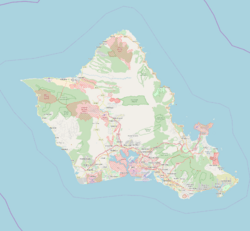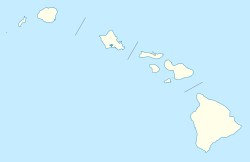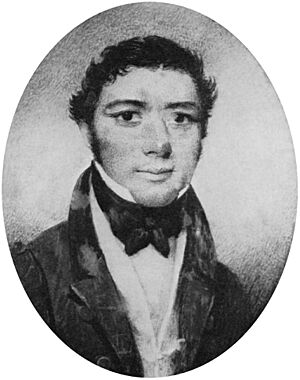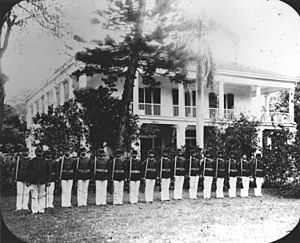Washington Place facts for kids
|
Washington Place
|
|
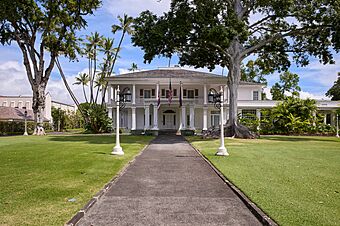
The building in 2024
|
|
| Location | 320 Beretania Street, Honolulu, Hawaii |
|---|---|
| Area | 3.1 acres (1.3 ha) |
| Built | 1847 |
| Built by | Isaac Hart |
| Architectural style | Greek Revival |
| Part of | Hawaii Capital Historic District (ID78001020) |
| NRHP reference No. | 73000666 |
Quick facts for kids Significant dates |
|
| Added to NRHP | June 18, 1973 |
| Designated NHL | March 29, 2007 |
Washington Place is a beautiful old building in the Hawaii Capital Historic District in Honolulu, Hawaii. It was designed in a style called Greek Revival. This historic home is famous because Queen Liliʻuokalani, Hawaii's last queen, was held there during a big change in Hawaii's government.
Later, Washington Place became the official home for the governor of Hawaii. In 2007, it was recognized as an important National Historic Landmark. A new home for the governor was built nearby in 2008, so Washington Place could become a museum.
Contents
Building Washington Place
An American merchant sea captain named John Dominis (1796–1846) came to America in 1819. He moved to Hawaii in 1837 with his wife, Mary Jones Dominis, and their son, John Owen Dominis. Captain Dominis received some land in 1842 after winning a lawsuit.
He continued his sea voyages to earn money for building a house. In 1846, he sailed to China to buy furniture for the house, which was almost finished. Sadly, his ship was lost at sea, and Mary Dominis became a widow.
To support herself and her son, Mary rented out rooms in the house. One of the first people to stay there was Anthony Ten Eyck, an American official. He named the house "Washington Place" in 1848, honoring George Washington, the first U.S. president. King Kamehameha III officially approved the name.
The American flag was flown at the house until Mary Dominis passed away in 1889. Later, in 1917, Queen Liliʻuokalani raised the American flag at Washington Place. She did this to honor Hawaiian sailors who had died in World War I. Many people saw this as her way of showing support for the United States.
The building was designed by Isaac Hart, a master carpenter. He also helped build the first ʻIolani Palace. Daniel Jenner, an Italian master mason, helped construct the building. The inside was decorated by Israel Wright, a master painter. Native Hawaiians also helped build Washington Place.
The house was built with open porches, called lānai, on all sides. The lower walls and columns are made of coral stone. The upper floor is made of wood. Washington Place looks like other Greek Revival homes built in the southern United States. It has a square shape with a two-story porch and Tuscan columns. The inside has a traditional layout with four main rooms on each floor.
History of the Home
From 1849 to 1854, William Little Lee lived at Washington Place. He helped create a Western legal system in Hawaii. Lee also wrote the Great Mahele, which changed how land was owned in Hawaii.
Lydia Kamakaeha Pākī, who would become Queen Liliʻuokalani, married John Owen Dominis in 1862. This made Washington Place their private home. Mary Dominis, John's mother, passed away in 1889. John Owen Dominis died in 1891. He left the property to Liliʻuokalani, who had just become Queen after her brother, King Kalākaua, passed away.
Queen Liliʻuokalani and Washington Place
In 1893, important events happened at Washington Place during the overthrow of the Hawaiian Kingdom. The queen was held there by new government forces. She was later tried and then stayed at Washington Place for several months after being held at [[ʻIolani Palace]].
Queen Liliʻuokalani lived at Washington Place for the rest of her life. She passed away in a downstairs bedroom of the house on November 11, 1917. The home is very important to the people of Hawaii because of its connection to the Hawaiian Kingdom and Queen Liliʻuokalani.
The Governor's Mansion
Queen Liliʻuokalani described Washington Place as a "palatial dwelling" and a "choice tropical retreat."
On May 14, 1921, the government of Hawaii bought Washington Place for $55,000 from the Queen's estate. It was bought to be the official home for the Territorial Governor of Hawaii. Governor Wallace Rider Farrington remodeled it in 1922.
Washington Place was the home for twelve territorial and state governors of Hawaii. It served as the governor's residence until 2002. Then, it was turned into a historic house museum. It was added to the National Register of Historic Places in 1973 and became a National Historic Landmark in 2007.
In 2002, a new governor's residence was built behind the historic Washington Place, on the same property. This new home continues to serve as the governor's official residence.
Gallery
See also
 In Spanish: Washington Place para niños
In Spanish: Washington Place para niños


